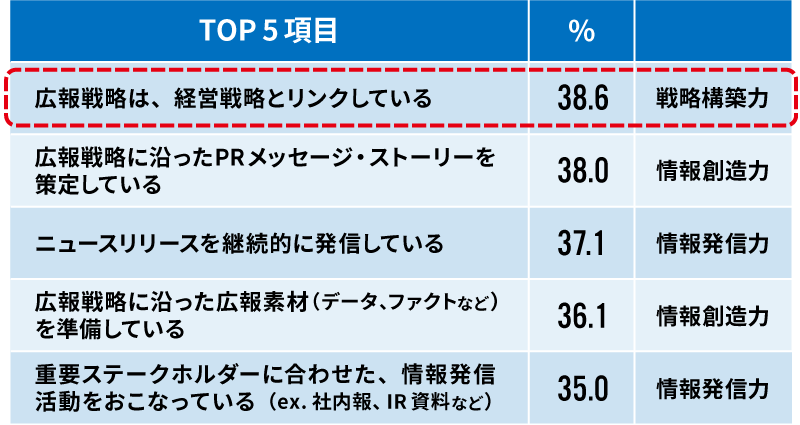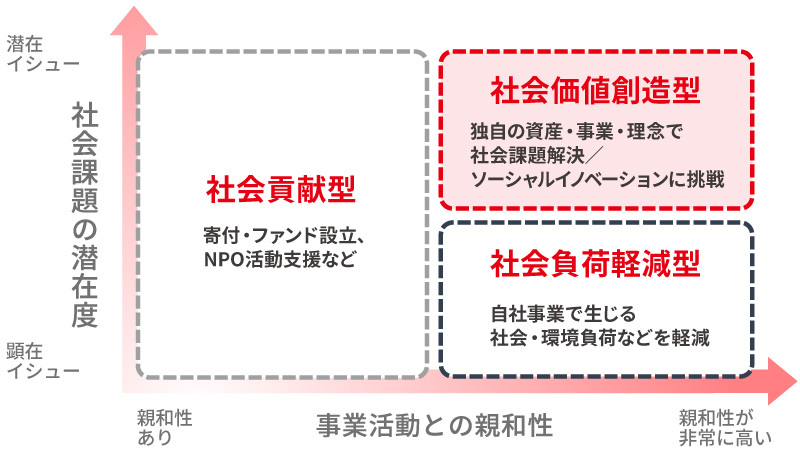This series introduces what "value-creating" PR means for companies moving forward.
In the past three installments, we've explained the importance of generating social value and positively impacting corporate brands, using "value creation" as our keyword.
In this final installment, we explain the key points for developing PR strategies that lead to creating that value.
The top capability PR departments want to strengthen is "strategy development"
Currently, the greatest challenge PR departments feel is "strategy development capability."
In the " 4th Corporate PR Capability Survey" conducted in 2020 by the Corporate PR Strategy Institute (abbreviated as C.S.I., within Dentsu Inc. PR), the item with the highest selection rate for desired future PR capability enhancement was "PR strategy is linked to management strategy" within the "strategy development capability" category [Figure 1].
While the subsequent items "information creation capability" and "information dissemination capability" are also crucial for PR, amid the emergence of societal issues exceeding previous expectations—including the COVID-19 pandemic—it appears an increasing number of companies are considering fundamental strategic revisions.
[Figure 1] Public relations activities companies wish to strengthen after the state of emergency is lifted (as of May 2020)

Are your company's "PR objectives" clearly defined?
So, how should a PR strategy be formulated?
Our institute defines PR strategy as shown in [Figure 2]: setting "PR objectives" and creating scenarios to achieve them. When setting these "PR objectives" – the first step in strategy formulation – it is crucial to clearly define the "desired state" based on the business strategy. This means thoroughly addressing: "① Which stakeholders?" and "② How do we want to be perceived?"
When initiating the formulation or review of a public relations strategy, it is relatively common to encounter the issue where these objectives are not clearly documented, or where key stakeholders have not been properly identified during the goal-setting process.
[Figure 2] PR Strategy = Setting "PR Goals" and the Scenario for Achieving Them

Furthermore, corporate strategy and public relations strategy are themes that should be more closely aligned. For example, "information disclosure and dialogue" has become a major theme in corporate governance in recent years.
In September last year, the Ministry of Economy, Trade and Industry published the " Report of the Study Group on Sustainable Enhancement of Corporate Value and Human Capital ~ Human Capital Version of the Ito Report~" (*), which strongly emphasized the importance of information disclosure and dialogue with stakeholders (see quoted text below). It is expected that this trend of disclosing and communicating corporate stance will intensify going forward.
"Information dissemination and dialogue" is a core competency of public relations. Beyond matters related to management and human resources, communicating the established PR strategy and PR goals broadly within and outside the company—demonstrating a commitment to addressing societal challenges—can also differentiate the company from its competitors.
Management should actively communicate and engage with employees regarding the company's philosophy, purpose, and talent strategy.
Management should visualize information such as how the company's talent strategy aligns with its business model and management strategy, and the progress of talent strategy initiatives, and actively communicate and engage with investors.
(*) Professor Kunio Ito
Specially Appointed Professor, Graduate School of Business Administration, Hitotsubashi University. Interviewed in "New Strategic Thinking in PR Management" published by this institute in December 2020.
Approach to Social Issues Rapidly Rising as Key PR Theme
Regarding the "stakeholders" that should be prioritized in "PR objectives," Part 1 of this series touched on the increasing importance of not only shareholders/investors and customers, but also employees and local residents. As the stakeholders we must engage with change or increase in number, prioritizing them within PR activities becomes crucial.
The next step is defining "how we want these stakeholders to perceive us." As mentioned in the first article, "CSR" has been the fastest-growing PR activity theme over the past six years. Communicating a stance as a "company addressing social issues" and building that reputation has become a critical theme for many companies today.
Aiming to build facts for "social value creation"
Addressing social issues is now a focal point for many companies. Given the vast scope of this theme, narrowing down the specific areas your company will tackle is crucial.
Our institute classifies corporate activities addressing social issues into three types: "Social Contribution Type," "Social Burden Reduction Type," and "Social Value Creation Type" [Figure 3].
Here, it is important to consider two axes: first, whether there is a high "affinity with business activities" (horizontal axis), and second, whether the company is addressing "potential issues (social challenges)" earlier than competitors (vertical axis). By tackling social challenges in the "Social Value Creation" domain, which satisfies both axes, companies can build a reputation for pursuing unique social innovation that harmonizes with their core business.
[Figure 3] Three Types of Social Issue Solutions Addressed by Companies

Analyzing PR Targets' Interests and Creating Effective Content Based on Facts
To enhance the precision of PR objectives and the resulting PR strategy, analyzing "what interests the PR target audience holds" is also crucial.
Data from the " 2020 ESG/SDGs Awareness Survey " shows that among the general public, health and welfare ranked first in interest, followed by energy in second place. Breaking this data down by age group reveals generational differences. For example, "End Poverty" (ranked 9th overall) appears as the 4th most important issue for those in their 20s. Thus, interests and concerns vary significantly depending on the PR target audience.
When narrowing down communication objectives in a PR strategy, it is crucial to consider the interests and concerns of the company's key stakeholders. This involves creating concrete facts that contribute to the communication objectives and then developing the content that follows.
[Figure 4] SDG Goals: Areas Where Companies Are Expected to Take Action (Multiple Responses)
[Chart 5] Age Group Comparison: SDGs Companies Should Address (Multiple Responses)
How to Build a PR Strategy that Leads to "Value Creation"
Based on the above, the key points for a PR strategy that addresses social issues and enhances corporate value are as follows:
- Define PR objectives: "Which stakeholders?" and "How do we want to be perceived?"
- Focus on social issues with high affinity to the business and high potential, aiming for differentiation
- Refine the facts that serve as the source of differentiation and develop them into content
We hope this article serves as a useful resource for enhancing your corporate value.
[Survey Overview]
■Corporate Public Relations Capability Survey
Survey Period: May 22, 2020 - August 7, 2020
Survey Target: Companies listed on the Tokyo Stock Exchange First Section, Second Section, Mothers, JASDAQ, Sapporo Securities Exchange, Nagoya Stock Exchange, and Fukuoka Stock Exchange at the time of publication in "Company Quarterly Report 2020" (3,679 companies)
Valid Responses: 474 companies (response rate: 12.9%)
Survey Method: Mail and online survey
Survey Sponsor: Corporate Public Relations Strategy Institute (within Dentsu Inc. Public Relations Inc.)
*Figures in this survey are rounded to the nearest hundredth.
■ESG/SDGs Survey
Survey Participants: 10,500 men and women aged 20 to 69 nationwide
Survey Method and Period: Online survey: June 24–30, 2020
Survey Questions: Awareness of ESG/SDGs, expected SDG initiatives from companies, degree of ESG consideration in investment decisions, etc.
Survey Participants

*This survey rounds figures to the nearest hundredth.











